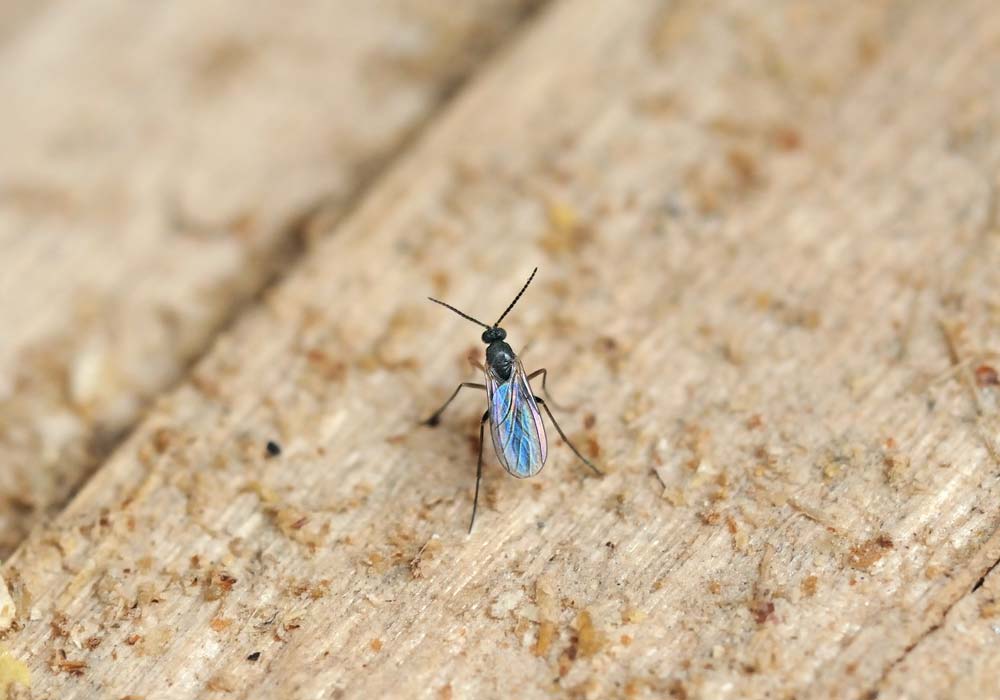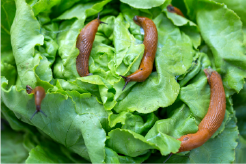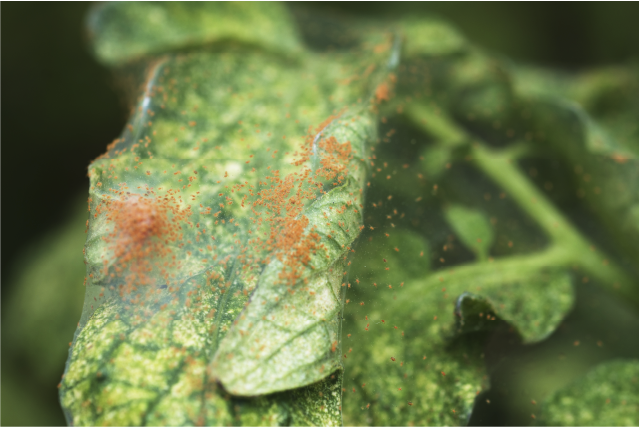What are sciarids?
Sciarids are small black flies, also called fungus gnats. Sciarid flies are a common pest for plants grown indoors as well greenhouses and propagation. The adult flies are a nuisance although they do not cause any direct damage to plants themselves. The larvae of fungus gnats like to live in moist soil and can feed on young roots and seedlings. There are several other groups of small flies which can be a problem for plants grown in homes and gardens including shore flies, moth flies and phorids. These other flies look very similar and can be controlled in the same way as sciarid flies.

Sciarid flies are particularly a problem for two reasons:
- Adult flies are a nuisance, often flying around pot-grown plants in a home, greenhouse or cold frame.
- Sciarid fly larvae (maggots) can feed on young growing roots in the soil or on newly emerged seedlings. Feeding on the stem of new seedlings can cause the seedling to die and the maggot feeding in general can create wounds which can act as sites of disease infection resulting in stunted plant growth or plant death.
How to identify sciarid
Because they are highly mobile the easiest way to identify sciarid fly adults in when they are trapped on yellow sticky traps. Sciarid fly are small slender black bodied flies, they have long thin legs and obvious antennae. Sciarid fly larvae (maggots) can be found in moist compost where they feed on young plant growth and algae. Fly larvae are soft bodied and cream in colour, with a black head capsule and no visible legs.
As well as sciarid flies (Sciaridae) there are a number of other groups of small fly species which cause similar problems. These include moth fly, phorid flies and shore flies. All have similar lifecycles and larvae look similar. Adult moth flies look like small moths with wide scale covered wings. Adult phorid flies are slightly larger than sciarids with more branched antennae. Shore fly adults are more solid in their appearance than sciarids. All of these group of flies are attracted to yellow sticky traps.
What plants attract sciarid fly?
Sciarid fly can be a pest of a wide range of plants including ornamental flowers and vegetables around the home, in greenhouses and in propagation cold frames.
Adult sciarids are very mobile. They lay their eggs within moist soil top layers of soil which is commonly found in house plants and young plant propagation settings. The larvae are generalist feeders moving through moist soil and feed on new plant root growth or the stems of seedlings and young plants.
What are the symptoms of sciarid fly damage?
The most obvious, and commonly seen first symptom of sciarid fly is adults flying around rather than the damage the presence or damage from the larvae. Early detection of adults with the help of yellow sticky traps notifies you of when they are present and laying their eggs and action should be taken to control the larvae before they damage the plants.
Large larvae can be seen with the eye crawling along the surface of soil the plant is growing in, or around the surface between root ball and plant pot. Symptoms of sciarid fly larvae feeding on seedling stems are bites taken out of the stem just above the soil surface, at this young delicate stage it does not take much to result in the death of the plant, which may appear as patches of dead seedlings within a seedling tray. Symptoms of feeding on the roots are poor plant condition, where its roots are unable to provide it with enough water and nutrition to appear healthy.
What treatments can be used against sciarid fly?
There are several biological control products available to control sciarid fly. It is possible to control different life stages of the fungus gnats with different biological products. Adults can be caught with yellow sticky traps which can either be hung from a glasshouse roof, or placed on sticks in the compost where space is more restricted.
Fungus gnat larvae can be controlled by using natural predators such as beneficial nematodes Steinernema feltiae (MightyNem® Sciarid Fly Killer) or predatory mites Hypoapsis miles (MightyBug™ Sciarid Fly Killer). Both of these natural predators have the advantage of moving through the soil after they have been applied to hunt the sciarid fly larvae.



